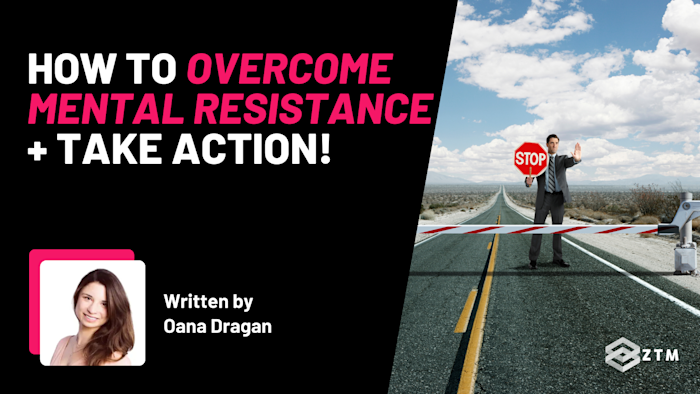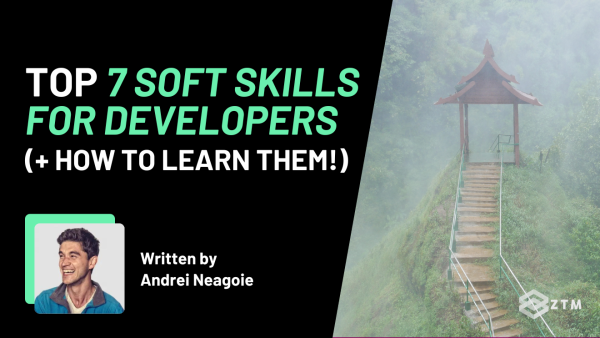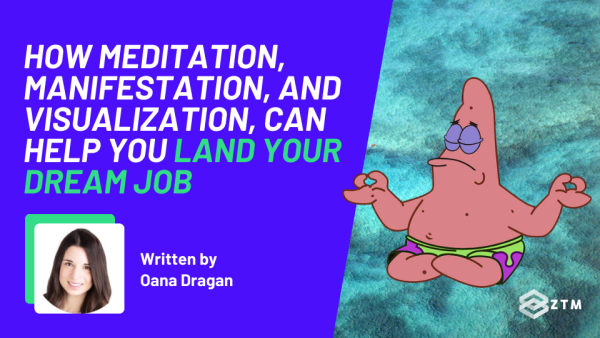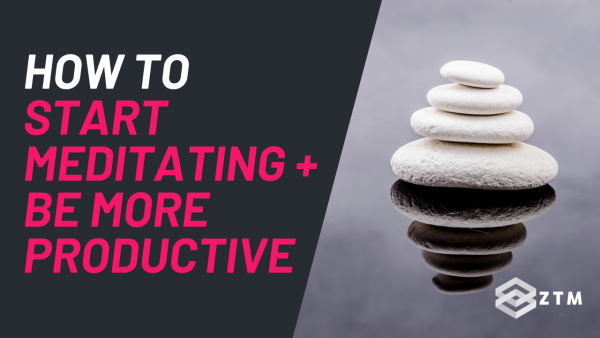Ever find yourself frozen in front of your screen, stuck in a loop of self-doubt, overwhelm, or just not knowing where to begin?
Maybe you were excited about a New Year’s goal, but before you knew it, you just spent 20 minutes doom scrolling social media and forgot why you were even on there.
You’re not alone in this. Mental resistance can hit anyone - especially when you’re diving into a brand-new skill, tackling a challenging problem, or even when just adding another programming language to your toolkit.
But here’s the good news: breaking free from these mental blocks isn’t as daunting as it feels. With the right mindset, proven strategies, and a little guidance, you can build momentum and start making meaningful progress - one small, intentional step at a time.
And in this guide I'll show you exactly how to do this, so let’s get started.
Sidenote: Here at ZTM, we’re a huge believer in improving soft skills if you want to become a 10x Developer.
One of the most powerful of which is meditation, simply because it allows us to be more calm, efficient, and even run our internal operating systems smoother!
So make sure to check out our soft skills courses - including my course on how to meditate to help you out with various aspects of your coding journey.
I just added a brand new guided meditation specifically designed to help you quiet the mental noise, reset your mindset, and step confidently into action mode. You can check that out for free via the link above.
If you like that, be sure to check out the rest.
With that out of the way, let’s get into what mental resistance is, why it’s not always a bad thing, and how to help get past it.
Understanding resistance: Why getting started feels so hard sometimes
At its core, resistance isn’t laziness or a lack of willpower. In fact, it's a natural response to threats.
You see, tasks that require focus, effort, and mental energy, such as solving a coding problem or learning a new framework, all trigger a natural instinct from your brain to avoid discomfort.
This is why your brain nudges you toward something easier and more familiar like scrolling your phone or watching one more tutorial instead of diving into the actual work.
But here’s the thing: resistance isn’t a sign of failure or weakness. It’s a sign that you’re on the edge of growth, stepping into something challenging yet meaningful. If you can overcome this feeling, you can make huge changes to your life.
The trick is just knowing how to get past it…
Tip #1. Acknowledge and accept your resistance if you want to get past it
The first step to overcoming resistance isn’t about fighting it, but instead recognizing it.
This is because resistance isn’t something to bulldoze through or ignore - It’s a signal. It’s your brain’s way of saying, “This feels uncomfortable. Are you sure we want to do this?”
But resistance isn’t a stop sign either. It’s just a signpost. It’s not telling you to quit; it’s pointing out that you’re on the edge of something challenging. So instead of suppressing it or feeling bad about it, simply notice it, say to yourself,
“This is resistance. I see it, and it’s okay that it’s here. It’s a sign I’m doing something new and important.”
That small moment of acknowledgment is powerful because it defuses the frustration, quiets guilt, and creates space for what comes next. Once you’ve done that, you’ll be ready to move forward.
But if you don’t address it and keep beating yourself up, you’ll struggle to get past it. So be kind to yourself!
Tip #2. Visualize yourself succeeding
Sometimes, the most powerful way to overcome resistance isn’t just through action — it’s through emotion. Success isn’t just something you achieve at the end; it’s a state of mind you can step into right now.
We often think, “I’ll feel proud once I finish this task.” But neuroscience tells us we can actually borrow that feeling of success before we even start—and it makes taking action so much easier.
Why visualization works
It’s pretty crazy, but our brains don't always distinguish between imagination and reality.
In fact, research has shown that mentally rehearsing an activity can create the same neurological changes as physically performing it.
For example:
In a study by Pascal Leone of music and the brain, they found that participants who mentally practiced a five-finger piano sequence on an imaginary piano for two hours a day showed the same neurological changes and reduction in mistakes as those who physically practiced on an actual piano.

Simply put, visualizing doing something successfully can help you to then do the task in real life successfully.
Editor’s note: I remember having an incredibly vivid dream about a skateboard trick when I was a kid. I had never done it before or even tried it.
The next day as I skated into town, I remembered the dream and did the trick perfectly on the first try. I was so shocked I jumped off my board, but I remember how my body did all the movements as if I had done it 1,000 times. So yeah, this definitely works.
Here’s how to do this:
- Visualize your success: Close your eyes and vividly imagine completing your task. Picture your project running smoothly or your code finally working
- Feel the emotion: Let yourself feel the pride, satisfaction, or excitement of success. Don’t hold back—really lean into those feelings
- Act from confidence: Ask yourself, “If I already felt successful, what would I do next?” Then, do that thing.
This isn’t just positive thinking. And yes, it won’t always help you write your code if you’re not sure what you’re doing.
However, it will help to improve confidence and remove doubt, so that you can then focus on what you need to do instead. It might even help you visualize the problem and the actual solution so that you can at least get started which is key. (More on this in a second).
In fact, trying to get it perfect before you start is another major stumbling point and cause of mental resistance…
Tip #3. Let go of perfectionism
Perfectionism often feels like a strength because it pushes you to aim high and care deeply about the quality of your work.
“I’m going to be the best coder ever!”
But in reality, it can become one of the biggest obstacles to progress, simply because when ‘perfect’ is the goal, just getting started feels impossible.
Not only that but every mistake feels like failure, and finishing becomes a moving target you can never quite reach. And so instead of making progress, you stay frozen, convinced that if it can’t be perfect, it’s not worth doing at all.
What we need to realize is that progress doesn’t happen in perfect, polished leaps—it happens in rough, iterative steps.
For example
Imagine a sculptor standing in front of a massive block of marble, chisel in hand. If they expect their first few strikes to produce a flawless masterpiece, they’ll never start. Sculpting requires rough cuts, trial and error, and gradual refinement.
Coding is the same — it’s about getting something down first, then improving it step by step.
You need to embrace the suck and realize that your first draft of code won’t be perfect, and that it’s not supposed to be! But it’s necessary because you can’t refine what doesn’t exist.
Coding, like any skill, thrives on experimentation, testing, and gradual improvement. Expecting perfection on your first attempt creates pressure, hesitation, and an endless cycle of overthinking.
The good news is, there’s a few things we can do to get past this:
- Focus on progress, not perfection: Remind yourself that imperfect progress is still progress. It’s better to have a messy first draft of your code than an empty screen
- Set ‘Good Enough’ standards: Not every piece of code needs to be elegant or groundbreaking. Sometimes, functional is enough
- Embrace mistakes as learning opportunities: Every bug, every error message, and every failed attempt is a step toward mastery. Mistakes are feedback, not failure
- Iterate instead of overthinking: Treat your work like drafts. Write it first, test it, improve it later. Done is better than perfect
The great thing about embracing good enough and knowing you can improve, is it allows you to take that first step, which can change everything.
Tip #4: Take small steps and build momentum
When you’re facing a big project, trying to learn a new programming language, or tackling a complex coding problem, it’s easy to feel overwhelmed. The sheer size of the task can freeze you in place, leaving you stuck in hesitation and overthinking.
But here’s the truth: progress doesn’t happen in giant leaps — it happens in small, consistent steps.
This is actually a great thing and why we should always aim to just get one step done.
Why? Well, every tiny task you complete, such as writing one line of code, fixing one bug, or solving one problem, gives your brain a hit of dopamine, the feel-good chemical. It tells you that you did the right thing.
What's cool though is that once this happens, it makes you want to feel it again, which creates momentum, and allows us to take the next step and so on, which is how we ultimately get through that resistance.
For example
Imagine you’re standing at the top of a snowy hill with a tiny snowball in your hand. At first, every push feels small, almost insignificant. But with each roll, the snowball gets bigger and picks up speed.
That’s exactly how small steps build momentum. Each task you complete, no matter how minor, adds to your progress. And once you’ve built enough speed, stopping becomes harder than continuing.
But if you stop pushing that snowball, it stalls, and getting it moving again feels heavier and harder. That’s why the key to progress isn’t about heroic bursts of effort—it’s about showing up consistently and keeping the snowball moving.
Here’s how to get started quickly and do that one next step
- Shrink the task: Break your goal into the smallest possible action. Instead of saying, “I need to finish this app,” say, “I’ll write one function today”
- Focus on the next step only: Don’t get overwhelmed by the big picture. Ask yourself, “What’s the very next thing I can do?” Maybe it’s fixing one bug, opening your editor, or writing one line of code
- Set tiny, achievable milestones: Write one function. Debug one error. Read one section of documentation
- Remove friction points and make it easy to start: Keep your tools ready, your workspace organized, and your editor open
- Stay consistent: Show up regularly, even if it’s just for 15 minutes a day. Small, repeated efforts compound into significant progress. In fact, studies have proven that this helps you learn faster and remember for longer vs large stretches of learning
- Celebrate Tiny Wins: Take a moment to acknowledge every completed task, no matter how small. Those little wins create momentum and reinforce your progress
Take action and get past your own mental resistance today
Overcoming resistance isn’t about waiting for motivation to strike or trying to force perfection—it’s about taking small, consistent actions that build momentum over time.
You’ve learned how to visualize success, break tasks into manageable steps, let go of perfectionism, and maintain momentum. Each of these strategies is a tool you can use whenever you feel stuck, uncertain, or overwhelmed.
But here’s the thing: none of it works unless you take that first step.
Sometimes, though, taking that first step feels impossible — no matter how many strategies you have. That’s where my new meditation comes in.
(Click to watch it for free).
It’s designed specifically to help you break free from resistance, quiet that inner doubt, and shift your mindset into action mode.
So if you’re tired of feeling stuck, or if you just need a little extra push to get started, this meditation is for you.
Take a breath, hit play, and let it guide you toward that first step.
You’ve got this.


![Learning to Meditate [Productivity & Focus]](https://images.ctfassets.net/aq13lwl6616q/2a7NI2zgRFphCk8pnDHBYF/34433f9991c8952427f112d428014bc6/Meditation_Thumbnail_2-_Academy.png?w=600&h=335&q=50&fm=png&bg=transparent)

![Learning to Learn [Efficient Learning]](https://images.ctfassets.net/aq13lwl6616q/6VWcUgLgG0SU55ORlILe2S/e186361aeb48561bcd19ae6486577022/Learning_to_Learn.jpg?w=600&h=336&fl=progressive&q=50&fm=jpg&bg=transparent)




